- The Growing Need for Home Security
- Types of Home Security Systems
- Key Components of Home Security Systems
- Benefits of Professional Vs. DIY Installation
- Economic Impact of Home Security
- Technological Advancements in Home Security
- Integration with Smart Home Devices
- Future Trends in Home Security Solutions
The Growing Need for Home Security
In recent years, the need for home security has significantly increased due to various factors. Property crime statistics highlight the urgency for effective security measures. According to the Federal Bureau of Investigation (FBI), in 2019 alone, there were approximately 7 million property crime offenses in the United States, resulting in estimated losses of $15.8 billion.
The rise in property crime rates is not only limited to urban areas. Suburban and rural regions have also seen an uptick in break-ins and burglaries, emphasizing the necessity for enhanced security systems across diverse geographical locations. This growing concern has prompted homeowners to invest in advanced home security solutions to protect their properties and ensure the safety of their families.
Technological advancements have also rendered traditional security measures, such as basic locks and alarms, less effective against modern threats. Today’s intruders are often equipped with sophisticated tools to circumvent these outdated systems. Consequently, contemporary home security installations now incorporate high-tech solutions like smart cameras, motion sensors, and digital locks, which offer superior protection and are more resistant to tampering.
Here are some key statistics that underline the growing need for home security:
- A study by Safewise in 2020 noted that homes without a security system are 300% more likely to be broken into.
- The National Council for Home Safety and Security reported that only 24% of U.S. homes have a functioning security system installed, indicating a substantial gap in protection for many households.
Moreover, the COVID-19 pandemic has influenced criminal behavior patterns. While many people were confined to their homes, the presence of valuable electronics and the general shift to remote work made residential properties more enticing targets for theft.
Investment in home security installation services is also backed by insurance incentives. Many insurance companies provide discounts on premiums for homes equipped with professional security systems. This not only enhances safety but also contributes to financial savings for homeowners.
The need for robust home security has become more pronounced due to the evolving nature of threats and the limitations of traditional systems. As a result, the industry is orienting itself toward comprehensive and technologically advanced solutions to address these challenges effectively.
The following table provides a quick overview of crime statistics relating to property crimes:
| Year | Property Crimes Reported |
|---|---|
| 2017 | 7.6 million |
| 2018 | 7.2 million |
| 2019 | 6.9 million |
These statistics demonstrate an ongoing issue that necessitates the adoption of modern security practices to ensure property safety.
Types of Home Security Systems
Home security systems come in various types, each designed to cater to specific security needs and preferences. Understanding the types available can help homeowners make informed decisions about which system best suits their requirements. The primary types of home security systems include monitored, unmonitored, wireless, and wired systems.
Monitored Systems: These systems are connected to a professional monitoring center that operates 24/7. When an alarm is triggered, the center is notified, and they take appropriate action, such as contacting the homeowner or emergency services. This provides an added layer of security as professional
help can be dispatched even if the homeowner is unavailable.
Unmonitored Systems: Also known as self-monitored systems, these rely on the homeowner to respond to alarms. The system emits loud sirens to alert anyone nearby and may also send notifications via smartphone applications or texts. While they typically have no monthly fees, the responsibility of responding to alarms falls entirely on the homeowner.
Wireless Systems: Wireless systems use radio frequency signals to transmit data between central control panels and various sensors. They are easier to install and offer greater flexibility in terms of placement. Wireless systems are often more aesthetically pleasing and less invasive as they do not require drilling or extensive wiring.
Wired Systems: Traditional wired systems connect sensors to the central control panel through physical wires. They are generally considered more reliable than wireless systems due to reduced susceptibility to interference. However, installation is more complex, often requiring professional assistance to manage the wiring throughout the property.
Below is a comparison table summarizing the main differences between these types of home security systems:
| Type of System | Key Characteristics |
|---|---|
| Monitored | Connected to a professional monitoring center; 24/7 support; additional service costs |
| Unmonitored | Alerts the homeowner directly; no recurring fees; user responsible for response |
| Wireless | Easy installation; flexible placement; potential for signal interference |
| Wired | Reliable performance; complex installation; requires professional setup |
Choosing the right type of home security system involves considering various factors, including budget, level of desired security, ease of installation, and personal preferences. Consulting with a professional can also provide valuable insights into which system would be most effective for a particular home environment.
Key Components of Home Security Systems
Home security systems are composed of several key components designed to work together to protect property and ensure the safety of individuals within the home. Understanding these components is crucial for anyone considering the installation of a home security system.
1. Control Panel: The control panel is the central hub of a home security system. It communicates with all other components and allows the user to arm or disarm the system. Modern control panels often include touch screens and can be operated remotely via smartphone apps.
- Function: Coordinates signals from sensors, cameras, and alarms, and communicates with monitoring services.
- Features: May include keypads, display screens, and portable key fobs for remote operation.
2. Sensors: Sensors detect unauthorized entry or unusual activity. They include door and window sensors, motion detectors, and glass break detectors.
- Door and Window Sensors: These sensors trigger an alarm if a door or window is opened when the system is armed.
- Motion Detectors: Detect movement within a certain range. Advanced models can distinguish between humans and pets.
- Glass Break Detectors: Activate an alarm if they sense the sound frequency of breaking glass.
3. Surveillance Cameras: Cameras monitor activity in and around the home. There are various types, including indoor, outdoor, and doorbell cameras.
- Indoor Cameras: Used to monitor the interior of the home and identify intruders.
- Outdoor Cameras: Designed to withstand weather conditions and monitor the perimeter of the property.
- Doorbell Cameras: Provide video and audio communication with visitors at the door.
4. Alarms: Alarms serve to alert homeowners and deter intruders. They can be auditory, visual, or both.
- Auditory Alarms: Produce a loud sound to alert occupants and neighbors, potentially scaring off intruders.
- Visual Alarms: May include flashing lights to provide a clear visual signal of a security breach.
5. Monitoring Systems: These include professional monitoring services that notify authorities when alarms are triggered. Monitoring can be continuous or on-demand.
- Professional Monitoring: Security companies offer 24/7 monitoring, ensuring a rapid response to any alerts.
- Self-Monitoring: Homeowners receive alerts directly on their smartphones and decide on the necessary actions themselves.
6. Environmental Sensors: Beyond security, these sensors monitor environmental hazards such as smoke, fire, carbon monoxide, and water leaks.
- Smoke and Fire Detectors: Notify occupants and emergency services in case of fire.
- Carbon Monoxide Detectors: Alert to the presence of this dangerous, odorless gas.
- Water Sensors: Detect leaks or flooding, helping to prevent water damage.
The integration of these components ensures comprehensive protection for homes. Each element plays a specific role in safeguarding property and providing peace of mind to homeowners.
Benefits of Professional Vs. DIY Installation
When considering home security installation, homeowners are often faced with the decision of whether to opt for professional installation services or to undertake a Do-It-Yourself (DIY) approach. Each method has its own set of benefits and drawbacks, which can greatly influence the effectiveness and reliability of the home security system.
Professional Installation ensures that the security system is installed by experts who have extensive knowledge and experience in the field. This can provide peace of mind, knowing the system will be operational and optimized for the specific layout and features of the home. Additionally, professional services often come with warranties and support, which can be crucial for maintaining the system in the long term.
Advantages of Professional Installation:
- Expertise: Trained professionals can handle complex installations and troubleshoot potential issues quickly.
- Comprehensive Coverage: Professionals ensure that all components work together seamlessly and cover all vulnerable areas of the home.
- Support: Access to customer service and tech support in case of malfunction or queries.
- Time-Saving: Installation is typically faster and more efficient.
DIY Installation offers homeowners the flexibility to install their security systems at their own pace and often at a lower cost. Many modern systems are designed to be user-friendly, with easy-to-follow instructions and online resources to guide the process.
Advantages of DIY Installation:
- Cost-Effective: Generally cheaper as it eliminates the need for professional labor costs.
- Flexibility: Homeowners can install and configure the system according to their unique needs and preferences.
- Learning Experience: Provides an opportunity to learn about the system’s functionality and features.
- No Scheduling: Installation can be done at any time, without the need to coordinate with professional schedules.
The choice between professional and DIY installation can be influenced by various factors, including the complexity of the system, budget constraints, and the homeowner’s technical skills and comfort level with installation processes. Below is a comparative table summarizing some key aspects:
| Aspect | Professional Installation | DIY Installation |
|---|---|---|
| Expertise | High | Variable |
| Cost | Higher | Lower |
| Time Required | Usually faster | Dependent on homeowner’s availability |
| Support and Warranty | Included | Limited or optional |
Ultimately, both professional and DIY installations can effectively enhance home security, but the best choice depends on individual circumstances and preferences. Homeowners should weigh the benefits and disadvantages of each method to make an informed decision that best suits their needs.
Economic Impact of Home Security
Investing in home security installation services can have a significant economic impact on both individual households and the broader community. At the household level, the immediate financial outlay for an advanced home security system might seem substantial, but the long-term economic benefits often outweigh these initial costs.
One of the primary economic advantages is the potential reduction in home insurance premiums. Many insurance companies offer discounts to homeowners who install comprehensive security systems. These discounts can range between 5% to 20%, according to the Insurance Information Institute. As a result, the cost savings on insurance over several years can help offset the initial installation expenses.
A home security system can also increase property values. Real estate experts, like those from the National Association of Realtors, have noted that prospective buyers are willing to pay more for homes equipped with advanced security technology. This added value can make a significant difference in the real estate market, especially in high-crime areas where security is a top concern for buyers.
Moreover, a home security system can lead to the preservation of valuable personal and property assets. By preventing burglaries and vandalism, homeowners can avoid substantial financial losses associated with replacing stolen or damaged property. The FBI’s Uniform Crime Reporting Program states that the average dollar loss per burglary is over $2,000. An effective security system can act as a deterrent to such crimes and thus save homeowners from these potential losses.
The economic impact also extends to the broader community. Studies have shown that widespread adoption of home security systems in a neighborhood can lead to a decrease in local crime rates. For example, a study by Rutgers University found that increases in home security system usage led to a reduction in the incidence of residential burglaries. Reduced crime rates can foster a more stable and prosperous community environment, potentially boosting local economic activity and property values for all residents.
In summation, the economic impact of investing in home security installation services is multifaceted. It includes potential insurance savings, increased property values, prevention of financial losses due to crime, and broader community benefits through crime deterrence. While the initial investment may be significant, the long-term financial benefits make home security systems a prudent economic choice for many homeowners.
Technological Advancements in Home Security
Technological advancements in the home security sector have revolutionized how security systems are designed, installed, and managed. These innovations have led to increased efficiency, reliability, and user convenience. Several key technologies are driving these changes, offering enhanced protection and expanded functionality.
Artificial Intelligence (AI) and Machine Learning: AI and machine learning algorithms have significantly improved the detection capabilities of home security systems. These technologies enable systems to analyze patterns, recognize unusual activities, and reduce false alarms. For instance, AI-powered cameras can distinguish between pets, people, and vehicles, minimizing unnecessary alerts.
Wireless and Cellular Technology: Modern home security systems increasingly rely on wireless and cellular technology instead of traditional wired connections. This development not only simplifies installations but also ensures continuous monitoring, even during power outages or intentional line cuts. Cellular backup provides an additional layer of security by maintaining communication with monitoring centers when the primary internet connection fails.
Smart Sensors: Advancements in sensor technology have led to the creation of more intelligent and versatile devices. These smart sensors can detect a wide range of conditions including motion, temperature changes, water leaks, and air quality. Enhanced sensitivity and accuracy enable faster and more reliable responses to potential security breaches.
Biometric Verification: Biometric technologies, such as fingerprint recognition, facial recognition, and voice authentication, provide more secure access control methods. These systems reduce the risk of unauthorized entry by ensuring that only registered individuals can gain access to the property. The adoption of biometric solutions has been growing due to their high reliability and ease of use.
Cloud Computing: The integration of cloud computing in home security systems allows for improved data storage, management, and accessibility. Security footage and system logs can be securely stored in the cloud, providing users access to real-time and historical data from any location. This technology also supports remote system updates and maintenance, ensuring that security measures are always up-to-date.
Internet of Things (IoT): The IoT has facilitated the development of interconnected home security devices that communicate with each other to create a cohesive security network. From smart cameras and doorbells to integrated alarm systems, IoT-enabled devices offer seamless coordination and centralized control through smartphone apps or home automation platforms.
These technological advancements are continuously shaping the landscape of home security, providing users with more robust and user-friendly solutions. The ongoing evolution of these technologies promises to further enhance the effectiveness and convenience of home security systems in the future.
Integration with Smart Home Devices
In recent years, the advent of smart home technology has significantly enhanced the functionality and convenience of home security systems. Integrating home security systems with smart home devices provides homeowners with comprehensive control and monitoring capabilities, leading to improved safety and streamlined management.
Enhanced Control and Monitoring
Smart home devices such as smart locks, cameras, and sensors can be seamlessly integrated with home security systems. This integration allows homeowners to control and monitor their security environment through a single, unified interface. For instance, smart locks can be operated remotely via smartphones, providing real-time access control and notifications. This functionality dramatically increases the convenience of managing home security, particularly for those frequently on the move.
Interconnected Systems
Modern home security systems can connect with various smart devices to create a network of interconnected systems. Key integrations include:
- Security Cameras: Live feeds and recorded footage from security cameras can be accessed and controlled through smart home hubs or mobile applications.
- Smart Lighting: Integrating lighting systems with security sensors can deter potential intruders by simulating occupancy when the home is vacant.
- Environmental Sensors: Devices such as smoke detectors, carbon monoxide detectors, and flood sensors can be incorporated to provide comprehensive safety alerts directly to the homeowner’s mobile device.
Automation and Convenience
Home security systems enhanced with smart home integration offer automation capabilities that simplify daily routines. For example, automated routines can be set up to lock doors, arm alarms, and adjust lighting at predetermined times or in response to specific triggers, such as leaving the house or going to bed. This level of automation minimizes human error and ensures that security measures are consistently maintained.
Energy Efficiency and Cost Savings
Combining home security systems with smart home devices can also lead to energy efficiency and cost savings. Smart thermostats, for instance, can be programmed to optimize heating and cooling based on security system status. When the system detects that the home is unoccupied, the thermostat can automatically adjust to more energy-efficient settings, thereby reducing energy consumption and lowering utility bills.
Increased Safety and Peace of Mind
The integration of home security systems with smart home devices enhances overall safety and provides peace of mind. Homeowners receive real-time alerts and notifications about any potential security breaches or environmental hazards, allowing them to respond promptly. Additionally, having all security and smart home devices connected and controlled through one platform ensures that nothing is overlooked, leading to a more secure and well-managed home environment.
Future
Trends in Home Security Solutions
As technology continues to evolve, the future of home security solutions promises increasingly sophisticated and integrated systems that enhance the safety and convenience of residential and commercial properties.
Emergence of Artificial Intelligence (AI) and Machine Learning
Artificial Intelligence (AI) and Machine Learning are set to play a major role in the future of home security. These technologies enable systems to learn from patterns and predict potential security threats. AI can analyze vast amounts of data from various sensors and cameras to recognize unusual activities, providing real-time alerts to homeowners.
Internet of Things (IoT) Integration
The Internet of Things (IoT) is revolutionizing home security by facilitating the interconnectivity of various devices. Homeowners can expect a seamless integration of security systems with other smart home gadgets, such as smart locks, lights, and thermostats, enhancing both security and convenience.
Enhanced Biometric Verification
Biometric verification technologies, including facial recognition and fingerprint scanners, will become more prevalent. These methods offer a higher level of security by ensuring that only authorized individuals can access the property.
5G Connectivity
The rollout of 5G networks will significantly improve the reliability and speed of home security systems. With faster data transmission, real-time video streaming, and prompt alerts, homeowners will have a more responsive and dependable security setup.
Advanced Alarm Monitoring Services
Future alarm monitoring services will leverage advanced technologies to offer more comprehensive coverage. For example, Allied, an award-winning home security installation and alarm monitoring company in Texas, already provides police, medical, and fire alarm monitoring as part of their security packages. These services are expected to become even more integrated and responsive.
Voice-Activated Systems
Voice-activated controls, powered by AI assistants like Amazon Alexa and Google Assistant, will become more sophisticated in managing home security. These systems will allow homeowners to control various security features through simple voice commands, providing an added layer of convenience.
Environmental and Health Monitoring
In addition to traditional security measures, future systems will monitor environmental factors such as smoke, carbon monoxide, and water leaks. Allied already offers these features, ensuring comprehensive safety for their clients. Health monitoring, including the detection of falls for elderly residents, could also become a standard feature.
Customization and Scalability
Future home security solutions will offer greater customization and scalability, allowing homeowners to tailor their security systems to their specific needs. Companies like Allied provide a wide range of smart home security and surveillance systems, ensuring that systems can grow and adapt according to individual requirements.
Cybersecurity Measures
As more components of home security systems become connected to the internet, the importance of robust cybersecurity measures cannot be overstated. Future systems will incorporate advanced encryption and security protocols to protect against hacking and unauthorized access.
To stay ahead of these trends, companies like Allied are continually innovating and upgrading their offerings. With decades of experience serving Texas and a commitment to exceptional customer service and competitive pricing, Allied is well-positioned to meet the evolving security needs of homeowners and businesses alike.
As the landscape of home security continues to advance, the integration of these cutting-edge technologies will ensure that the future of home security solutions is not only smarter but also more effective in protecting lives and properties.













